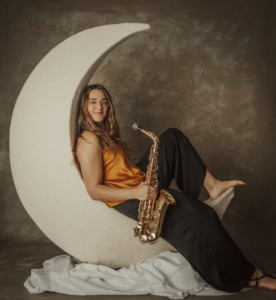Program Notes – February 1, 2025
Written by Todd Giles
Michael Torke: Tahiti, for Ensemble (2009)
Michael Torke (b. 1961) is an American composer from Milwaukee who gained recognition in the late 1980s and 1990s for works like Javelin, Color Music, and Telephone Book. Often described as a post-minimalist, Torke’s music brings together the repetitive structures of his minimalist predecessors with techniques from both the classical and modern pop traditions. His music is bright, energetic, colorful, and rhythmic—at times feeling almost impulsive. In a recent online interview, Torke said, “my music is optimistic, joyful, and buoyant. I try to write music that makes people feel good; for me music is not about personal expression or an attempt to describe the horrors of existence.”
The eight-movement Tahiti, for Ensemble was composed in 2009 for Ensemble 10/10, a subset of the Liverpool Philharmonic. On the program tonight we will hear five of the work’s eight movements. Torke’s CD titled Tahiti, which also includes Fiji, for Ensemble, won the Independent Music Awards for Best Instrumental Album in 2012. According to the composer’s program note for Tahiti, “[e]ach of the movements reminisces a feeling of the individual islands that make up the Society Islands in the South Pacific, which we generally refer to as Tahiti.” The work serves, then, as a kind of sensorial travelogue, evoking the landscapes and atmospheres of the French Polynesian islands. Each movement is named after one of the islands and is accompanied by a brief descriptor, such as “Morrea—Green Cliffs,” “Tahaa—White Sand,” and “Bora Bora—Lagoon.” In his CD liner notes, Torke reiterates that the pieces do not specifically reflect exact traits of their namesakes; rather, they “attempt to capture the perfume of leisure time in a very warm and sunny beautiful place.”
The vibrant opening movement, “Tahiti—Papeete,” envelopes us in its dynamic rhythms and energetic orchestration, pointing us to the capital city’s lively atmosphere. In typical Torke fashion, we hear a mix of brisk, syncopated patterns and bright, colorful instrumentation. The “Green Cliffs” of “Moorea” are lush and lyrical, featuring percussion that emulates a solitary drummer playing in a relaxed, half-time rhythm, while the strings and winds exchange gently syncopated melodies with a wistful quality. “Bora Bora—Lagoon” gently guides the listener with its soaring winds and sparkling percussion. The “White Sand” of “Tahaa” introduces a fresh rhythm that weaves through the orchestra, accompanied by flowing string lines and extended wind passages. “Huahine—Under the Moonlight” washes over us with its languid, pulsing rhythms and an evocative clarinet solo.
In his program note, Torke quotes Moby-Dick’s Ishmael, saying, “For as this appalling ocean surrounds the verdant land, so in the soul of man there lies one insular Tahiti, full of peace and joy, but encompassed by all the horrors of the half-known life. God keep thee! Push not off from that isle, thou canst never return!” As Torke himself says, Tahiti presents “A certain humidity, along with the lush landscape, water-life, white sand, and palm trees brings relief, a kind of peace to a hurried soul.” Cast off at your own risk.
Takashi Yoshimatsu: Saxophone Concerto Cyber Bird, Op. 59 (1993–94)
Contemporary composer Takashi Yoshimatsu (b. 1953) blends the modern techniques of rock and jazz with traditional Japanese elements to create neo-Romantic works recognizable for their emotional depth, complexity, and eclectic style. To date, Yoshimatsu has composed six symphonies, ten concerti for a variety of instruments, including marimba, guitar, and both alto and soprano saxophone, as well as a variety of other orchestral, solo, and chamber works, including several for Japanese instruments.
Yoshimatsu studied composition at the Tokyo University of the Arts and later at the Royal College of Music in London. His work embraces a more melodious, harmonically pleasing style compared to much of the atonal music prevalent in the 20th century. Not only does his style speak to the neo-Romantic label, so too does the fact that many of his works explore our relationship with the natural world—including outer space—as seen not only in Cyber Bird, but also works like Guitar Concerto “Pegasus Effect,” Trombone Concerto “Orion Machine,” Ode to Birds and Rainbow, and the Kamui-Chikap Symphony. (A Chikap-kamui is a mythological owl-like being responsible for overseeing the behavior of the Ainu people of Northern Japan).
Cyber Bird premiered under the baton of Masahiko Enkoji leading the Yomiuri Symphonie Orchestra on March 21, 1994, with saxophonist Nobuya Sugawa. Although classified as a saxophone concerto, Yoshimatsu has referred to Cyber Bird as a triple concerto due to the significant roles played by the piano and percussion, adding to its free jazz trio feel. The piece follows the conventional fast-slow-fast concerto structure, but presents it with a distinctly modern touch, incorporating rhythms, harmonies, and textures from rock, jazz, and Impressionism. The work’s subtitle, according to the composer, points to “an imaginary bird in the realm of electronic cyberspace . . . in which the saxophone, born by the orchestra’s wings, takes flight within this imaginary space, flying through a variety of classical, jazz, rock and ethnic scenes to reach its own stratum.”
The fast-paced opening movement, titled “Bird in Colors: Allegro,” begins with a vibrant and cheerful theme presented by the saxophone and piano, showcasing strong jazz influences. This theme builds to a dramatic climax, followed by a powerful burst of sound. The central section introduces a deeply lyrical second theme, played by the piano and saxophone, which is then followed by a more dynamic passage featuring syncopated, jazzy rhythms. “Bird in Grief: Andante,” the second, more delicate movement opens with the piano, accompanied by violin harmonics and impressionistic colors evoking a gliding bird, whereas the concluding part introduces a mix of chaotic, improvised sounds, gongs, string effects, and a return to the opening theme. According to Yoshimatsu, “The second movement, an elegy, was written in a hospital when I was up all night with my sister who was on a life-support machine battling with terminal cancer. The last thing she said before she died was ‘I would like to be a bird in my next life.’ This composition is stamped with the name of her soul.” The shortest and final movement, “Bird in the Wind: Presto,” starts by revisiting the opening theme from the first movement, followed by the brass and strings. The development is highly rhythmic, showcasing dynamic exchanges between soloists and the orchestra. Following a dramatic climax, the saxophone takes center stage with a brief cadenza accompanied by the percussion section. The music grows increasingly vigorous and assertive, gradually leading to an energetic coda reflecting the influence of rock on Yoshimatsu.
Claude Bolling: Suite for Chamber Orchestra and Jazz Piano Trio (1983)
Claude Bolling (1930–2020) was a French jazz pianist and composer whose 1975 crossover album Suite for Flute and Jazz Piano spent over a decade on the Billboard classical chart. Born in Cannes, France, Bolling studied at the Nice Conservatory and in Paris, where he lived the rest of his life. As a fourteen-year-old piano prodigy, the young Bolling was already making his name professionally with jazz greats such as Roy Eldridge, Lionel Hampton, and Kenny Clarke. His idol was Duke Ellington. Bolling collaborated with a range of other notable musicians and ensembles throughout his career, contributing to the development of jazz and its integration with classical elements. His works often feature lively, melodic lines and intricate arrangements that showcase his versatility and skill as a musician. In addition to his work as a composer, Bolling was an accomplished performer, bandleader, and composer of over one hundred film scores.
Following on the heels of his 1975 crossover success, Bolling composed his Suite for Chamber Orchestra and Jazz Piano Trio in 1983, which likewise blends classical and jazz elements into a seamless, engaging composition that both fans of jazz and classical alike find intriguing. The suite features aspects of the Baroque concerto grosso, with its small group of soloists alternating and blending with the larger orchestra. Known for its vibrant, playful character and intricate arrangements, the suite often invites the piano trio into the spotlight for improvisational solos while the orchestra provides a lush harmonic backdrop.
“Gracieuse” (Graceful) opens the suite with a Baroque-sounding theme that the trio transforms into a light jazzy waltz. Midway through, the mood shifts before the trio delves into a more bluesy style. The piano and soloists from the orchestra engage in playful solo exchanges before the initial theme reappears. The third movement, “Enjouée” (Playful) transforms a fugal theme introduced by the bassoon and oboe which is subsequently picked up by the orchestra into foot-tapping jazz with the trio. The closing movement, “Brilliante,” opens similarly to the first movement with its Baroque style, which is once again morphed into jazz by the trio. The relentless energy and momentum of this piece persist until the very last measure. The Suite for Chamber Orchestra and Jazz Piano Trio effectively bridges the gap between genres, celebrating both classical sophistication and jazz spontaneity in a work that is eminently fun and listenable.




